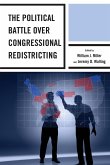Anne Marie Cammisa, Paul Christopher Manuel
The Path of American Public Policy
Comparative Perspectives
Anne Marie Cammisa, Paul Christopher Manuel
The Path of American Public Policy
Comparative Perspectives
- Gebundenes Buch
- Merkliste
- Auf die Merkliste
- Bewerten Bewerten
- Teilen
- Produkt teilen
- Produkterinnerung
- Produkterinnerung
The Path of American Public Policy: Comparative Perspectives demonstrates how ideas and institutions influence public policy formation in the United States. This book presents comparative cases of when comprehensive change in the United States failed and when it succeeded and ...
Andere Kunden interessierten sich auch für
![The Path of American Public Policy The Path of American Public Policy]() Anne Marie CammisaThe Path of American Public Policy64,99 €
Anne Marie CammisaThe Path of American Public Policy64,99 €![Pragmatic Vision Pragmatic Vision]() Meena BosePragmatic Vision28,99 €
Meena BosePragmatic Vision28,99 €![Audacity Audacity]() Jonathan ChaitAudacity22,99 €
Jonathan ChaitAudacity22,99 €![The Political Battle over Congressional Redistricting The Political Battle over Congressional Redistricting]() The Political Battle over Congressional Redistricting165,99 €
The Political Battle over Congressional Redistricting165,99 €![Mexicano and Latino Politics and the Quest for Self-Determination Mexicano and Latino Politics and the Quest for Self-Determination]() Armando NavarroMexicano and Latino Politics and the Quest for Self-Determination202,99 €
Armando NavarroMexicano and Latino Politics and the Quest for Self-Determination202,99 €![The Conservative Revolution of Antonin Scalia The Conservative Revolution of Antonin Scalia]() The Conservative Revolution of Antonin Scalia156,99 €
The Conservative Revolution of Antonin Scalia156,99 €![The Political Battle over Congressional Redistricting The Political Battle over Congressional Redistricting]() The Political Battle over Congressional Redistricting81,99 €
The Political Battle over Congressional Redistricting81,99 €-
-
-
The Path of American Public Policy: Comparative Perspectives demonstrates how ideas and institutions influence public policy formation in the United States. This book presents comparative cases of when comprehensive change in the United States failed and when it succeeded and ...
Hinweis: Dieser Artikel kann nur an eine deutsche Lieferadresse ausgeliefert werden.
Hinweis: Dieser Artikel kann nur an eine deutsche Lieferadresse ausgeliefert werden.
Produktdetails
- Produktdetails
- Verlag: Lexington Books
- Seitenzahl: 240
- Erscheinungstermin: 19. Dezember 2013
- Englisch
- Abmessung: 235mm x 157mm x 19mm
- Gewicht: 546g
- ISBN-13: 9780739186596
- ISBN-10: 0739186590
- Artikelnr.: 39396665
- Herstellerkennzeichnung
- Libri GmbH
- Europaallee 1
- 36244 Bad Hersfeld
- gpsr@libri.de
- Verlag: Lexington Books
- Seitenzahl: 240
- Erscheinungstermin: 19. Dezember 2013
- Englisch
- Abmessung: 235mm x 157mm x 19mm
- Gewicht: 546g
- ISBN-13: 9780739186596
- ISBN-10: 0739186590
- Artikelnr.: 39396665
- Herstellerkennzeichnung
- Libri GmbH
- Europaallee 1
- 36244 Bad Hersfeld
- gpsr@libri.de
By Anne Marie Cammisa and Paul Christopher Manuel
Preface Chapter 1: Of Ideas and Institutions: The Foundational Tension of
American Democracy Introduction Why Does American Government Appear to Be
Spinning Its Wheels? The Foundational Tension: Majority Rule versus
Minority Rights How the Foundational Ideational Tension Limits Innovative
Policy Development: Ideas Conceptualized as Cognitive Locks Conclusion
Structure of the Remainder of the Book Chapter 2: The Path of Political
Development in Great Britain and the United States: A Brief Comparative
History Why American Government Operates under Checks and Balances, and
British Government Does Not The Evolution of the British Parliament Key
Institutional Features of British Democracy The Creation of the American
Presidential System Key Institutional Features of American Democracy
Conclusion Chapter 3: Agenda Setting and Agenda Control: Case One: A
Legislative History of the 1994 Republican Contract with America The 1994
Contract with America Introduction to the 104th Congress The Framers' Fears
of the Tyranny of the Majority and the 1994 Republican Contract with
America Background: Where Did the Contract Come From? The Contract with
America The First Hundred Days of the 104th Congress American Congress
Function Differently than the British Parliament Chapter 4: Agenda Setting
and Agenda Control: Case Two: The 2008-2010 Battle over Health Care
Introduction Background Agenda Setting and Agenda Control Congress's Turn:
Policy Formation and Legitimation Welcome (Again) to the World of Checks
and Balances Conclusion: Lessons from the Past Chapter 5: What if American
Democracy Were on a Different Path? How a British-Style Parliamentary
System Could Change American Politics How American Political Development
Could Have Been on a Different Path How Selected Election Outcomes Might
Have Been Different Chapter 6: Conclusion: Ideas and Institutions Matter
Problem One: Divided Government Problem Two: Gridlock Problem Three: No
Means to Quickly Replace a Failed or Deadlocked Administration Some
Possible Solutions? Ideas and Institutions Matter Bibliography About the
Authors
American Democracy Introduction Why Does American Government Appear to Be
Spinning Its Wheels? The Foundational Tension: Majority Rule versus
Minority Rights How the Foundational Ideational Tension Limits Innovative
Policy Development: Ideas Conceptualized as Cognitive Locks Conclusion
Structure of the Remainder of the Book Chapter 2: The Path of Political
Development in Great Britain and the United States: A Brief Comparative
History Why American Government Operates under Checks and Balances, and
British Government Does Not The Evolution of the British Parliament Key
Institutional Features of British Democracy The Creation of the American
Presidential System Key Institutional Features of American Democracy
Conclusion Chapter 3: Agenda Setting and Agenda Control: Case One: A
Legislative History of the 1994 Republican Contract with America The 1994
Contract with America Introduction to the 104th Congress The Framers' Fears
of the Tyranny of the Majority and the 1994 Republican Contract with
America Background: Where Did the Contract Come From? The Contract with
America The First Hundred Days of the 104th Congress American Congress
Function Differently than the British Parliament Chapter 4: Agenda Setting
and Agenda Control: Case Two: The 2008-2010 Battle over Health Care
Introduction Background Agenda Setting and Agenda Control Congress's Turn:
Policy Formation and Legitimation Welcome (Again) to the World of Checks
and Balances Conclusion: Lessons from the Past Chapter 5: What if American
Democracy Were on a Different Path? How a British-Style Parliamentary
System Could Change American Politics How American Political Development
Could Have Been on a Different Path How Selected Election Outcomes Might
Have Been Different Chapter 6: Conclusion: Ideas and Institutions Matter
Problem One: Divided Government Problem Two: Gridlock Problem Three: No
Means to Quickly Replace a Failed or Deadlocked Administration Some
Possible Solutions? Ideas and Institutions Matter Bibliography About the
Authors
Preface Chapter 1: Of Ideas and Institutions: The Foundational Tension of
American Democracy Introduction Why Does American Government Appear to Be
Spinning Its Wheels? The Foundational Tension: Majority Rule versus
Minority Rights How the Foundational Ideational Tension Limits Innovative
Policy Development: Ideas Conceptualized as Cognitive Locks Conclusion
Structure of the Remainder of the Book Chapter 2: The Path of Political
Development in Great Britain and the United States: A Brief Comparative
History Why American Government Operates under Checks and Balances, and
British Government Does Not The Evolution of the British Parliament Key
Institutional Features of British Democracy The Creation of the American
Presidential System Key Institutional Features of American Democracy
Conclusion Chapter 3: Agenda Setting and Agenda Control: Case One: A
Legislative History of the 1994 Republican Contract with America The 1994
Contract with America Introduction to the 104th Congress The Framers' Fears
of the Tyranny of the Majority and the 1994 Republican Contract with
America Background: Where Did the Contract Come From? The Contract with
America The First Hundred Days of the 104th Congress American Congress
Function Differently than the British Parliament Chapter 4: Agenda Setting
and Agenda Control: Case Two: The 2008-2010 Battle over Health Care
Introduction Background Agenda Setting and Agenda Control Congress's Turn:
Policy Formation and Legitimation Welcome (Again) to the World of Checks
and Balances Conclusion: Lessons from the Past Chapter 5: What if American
Democracy Were on a Different Path? How a British-Style Parliamentary
System Could Change American Politics How American Political Development
Could Have Been on a Different Path How Selected Election Outcomes Might
Have Been Different Chapter 6: Conclusion: Ideas and Institutions Matter
Problem One: Divided Government Problem Two: Gridlock Problem Three: No
Means to Quickly Replace a Failed or Deadlocked Administration Some
Possible Solutions? Ideas and Institutions Matter Bibliography About the
Authors
American Democracy Introduction Why Does American Government Appear to Be
Spinning Its Wheels? The Foundational Tension: Majority Rule versus
Minority Rights How the Foundational Ideational Tension Limits Innovative
Policy Development: Ideas Conceptualized as Cognitive Locks Conclusion
Structure of the Remainder of the Book Chapter 2: The Path of Political
Development in Great Britain and the United States: A Brief Comparative
History Why American Government Operates under Checks and Balances, and
British Government Does Not The Evolution of the British Parliament Key
Institutional Features of British Democracy The Creation of the American
Presidential System Key Institutional Features of American Democracy
Conclusion Chapter 3: Agenda Setting and Agenda Control: Case One: A
Legislative History of the 1994 Republican Contract with America The 1994
Contract with America Introduction to the 104th Congress The Framers' Fears
of the Tyranny of the Majority and the 1994 Republican Contract with
America Background: Where Did the Contract Come From? The Contract with
America The First Hundred Days of the 104th Congress American Congress
Function Differently than the British Parliament Chapter 4: Agenda Setting
and Agenda Control: Case Two: The 2008-2010 Battle over Health Care
Introduction Background Agenda Setting and Agenda Control Congress's Turn:
Policy Formation and Legitimation Welcome (Again) to the World of Checks
and Balances Conclusion: Lessons from the Past Chapter 5: What if American
Democracy Were on a Different Path? How a British-Style Parliamentary
System Could Change American Politics How American Political Development
Could Have Been on a Different Path How Selected Election Outcomes Might
Have Been Different Chapter 6: Conclusion: Ideas and Institutions Matter
Problem One: Divided Government Problem Two: Gridlock Problem Three: No
Means to Quickly Replace a Failed or Deadlocked Administration Some
Possible Solutions? Ideas and Institutions Matter Bibliography About the
Authors








